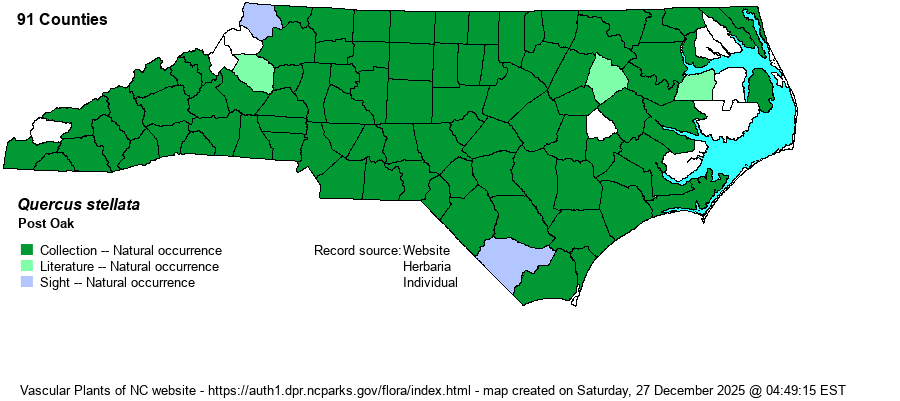| Author | Wangenheim | |
| Distribution | Essentially throughout the state, but as with many oaks it is scarce to locally absent in the far eastern counties near Albemarle Sound. A few counties in the northern Mountains appear to lack records, though it likely is present at the lowest elevations in such counties, near the Blue Ridge Escarpment.
This is a wide-ranging Eastern species, occurring from MA to southeastern NE, and south to central FL and central TX. It is scarce in the northern halves of the Midwestern states (e.g., OH, IN, IL).
| |
| Abundance | Common across the Piedmont and much of the western half of the Coastal Plain, including the Sandhills region. Locally fairly common, but not overly widespread, in the eastern half of the Coastal Plain, where suitable upland habitat can be uncommon. Fairly common in the southern half of the Mountains, but rare in the northern Mountains, where elevations are mostly too high for the species. | |
| Habitat | This is a characteristic species of upland forests, especially where soils are “clay-ish” or rocky, and typically over acidic soils. It is one of the main canopy species of the Dry Oak-Hickory Forest natural community. It can grow in drier floodplains or high (and dry) levees, but normally this is a species of gently rolling or relatively flat upland acidic soils. |
| Phenology | Flowers in April, and fruits from September to November of the same year. | |
| Identification | This is a familiar, medium deciduous tree, growing to about 60-70 feet tall on average. This is usually an easy tree to identify, as its “cross-shaped” leaves are distinctive. The leaves are medium-sized for an oak, being rather thick, and shiny dark green above and quite tomentose below. The leaves have a single large square-shaped lobe on each side, and a terminal lobe that is also similar in shape, with a squared off apex. A handful of other oaks have leaves a bit like Post Oak, but the lobes are not normally squared off, nor as thick in texture -– these include Sand Post Oak (Q. margarettiae), Bluff Oak (Q. austrina), and Swamp Post Oak (Q. similis). The latter two grow essentially only in floodplains or on bluffs or steep slopes on high pH soil; the first grows on dry and quite sandy soil. Sand Post Oak can occur with Post Oak in the Sandhills and a few other places, but that species has small leaves and they are not usually thick and glossy. | |
| Taxonomic Comments | None for the species, but note that Q. similis, and occasionally Q. margarettiae, are often subsumed within Q. stellata by some references. Most do list all three as valid species.
| |
| Other Common Name(s) | Iron Oak. Note that “Post Oak” is a nested name, as this name is found within Sand Post Oak and Swamp Post Oak. However, essentially no reference provides a modifier name for Q. stellata, and typically there is no confusion -– “Post Oak” is assumed to refer to Q. stellata, as it is much more widespread than the other two species. | |
| State Rank | S5 | |
| Global Rank | G5 | |
| State Status | | |
| US Status | | |
| USACE-agcp | UPL link |
| USACE-emp | UPL link |

